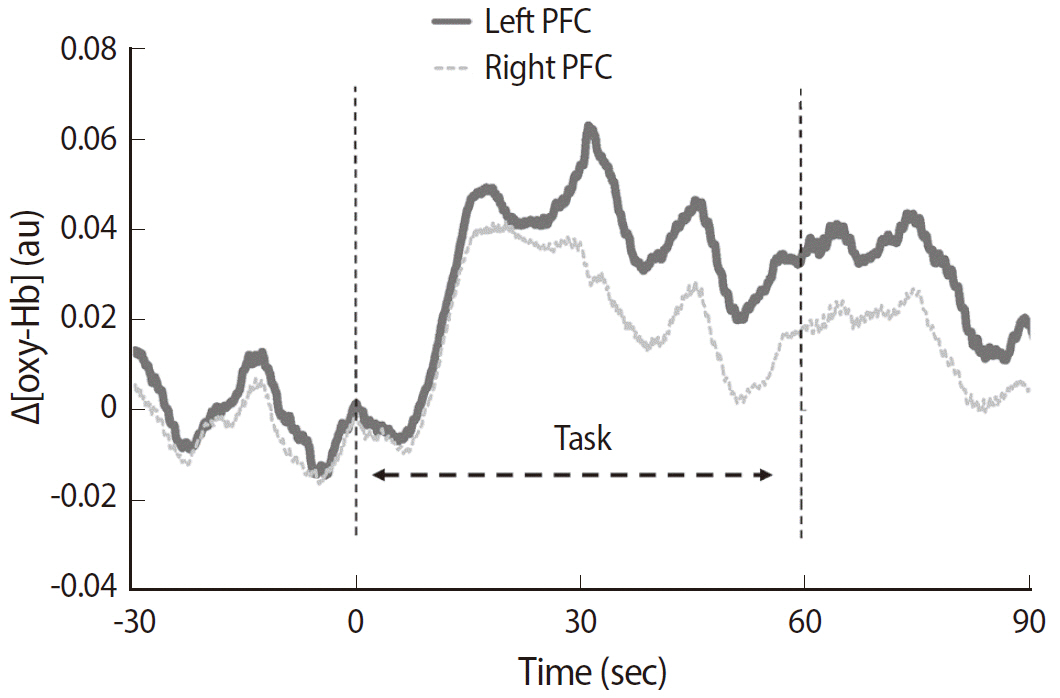J Educ Eval Health Prof.
2014;11:24. 10.3352/jeehp.2014.11.24.
Prefrontal hemodynamic responses and the degree of flow experience among occupational therapy students during their performance of a cognitive task
- Affiliations
-
- 1Department of Occupational Therapy, School of Health Science and Social Welfare, Kibi International University, Okayama, Japan. hirao.kazuki@gmail.com
- KMID: 2380943
- DOI: http://doi.org/10.3352/jeehp.2014.11.24
Abstract
- PURPOSE
Although flow experience is positively associated with motivation to learn, the biological basis of flow experience is poorly understood. Accumulation of evidence on the underlying brain mechanisms related to flow is necessary for a deeper understanding of the motivation to learn. The purpose of this study is to investigate the relationship between flow experience and brain function using near-infrared spectroscopy (NIRS) during the performance of a cognitive task.
METHODS
Sixty right-handed occupational therapy (OT) students participated in this study. These students performed a verbal fluency test (VFT) while 2-channel NIRS was used to assess changes in oxygenated hemoglobin concentration (oxygenated hemoglobin [oxy-Hb]) in the prefrontal cortex. Soon after that, the OT students answered the flow questionnaire (FQ) to assess the degree of flow experience during the VFT.
RESULTS
Average oxy-Hb in the prefrontal cortex had a significant negative correlation with the satisfaction scores on the FQ.
CONCLUSION
Satisfaction during the flow experience correlated with prefrontal hemodynamic suppression. This finding may assist in understanding motivation to learn and related flow experience.
Keyword
MeSH Terms
Figure
Reference
-
1. Nakamura J, Csikszentmihalyi M. The concept of flow. In : Snyder CR, Lopez S, editors. Handbook of positive psychology. New York: Oxford University Press;2005. p. 89–105.2. Asakawa K. Flow experience, culture, and well-being: how do autotelic Japanese college students feel, behave, and think in their daily lives? J Happiness Stud. 2010; 11:205–223. http://dx.doi.org/10.1007/s10902-008-9132-3.
Article3. Nakamura J, Csikszentmihalyi M. Flow theory and research. In : Lopez SJ, Snyder CR, editors. Oxford handbook of positive psychology. New York: Oxford University Press;2009. p. 195–206.4. Hirao K, Kobayashi R, Okishima K, Tomokuni Y. Influence of flow experience during daily life on health-related quality of life and salivary amylase activity in Japanese college students. Jpn J Occup Med Traumatol. 2011; 59:13–18.5. Hirao K, Kobayashi R. The relationship between self-disgust, guilt, and flow experience among Japanese undergraduates. Neuropsychiatr Dis Treat. 2013; 9:985–988. http://dx.doi.org/10.2147/NDT.S46895.
Article6. Hirao K, Kobayashi R, Yabuwaki K. Association of cognitive judgment and shyness with frequency and quality of flow experience. Psychol Res Behav Manag. 2012; 5:159–162. http://dx.doi.org/10.2147/PRBM.S37860.
Article7. Hirao K, Kobayashi R, Okishima K, Tomokuni Y, Yabuwaki K. Influence of different intensities of brief flow experiences on subjective and objective stress. Med Biol. 2011; 155:713–720.8. Dietrich A. Transient hypofrontality as a mechanism for the psychological effects of exercise. Psychiatry Res. 2006; 145:79–83. http://dx.doi.org/10.1016/j.psychres.2005.07.033.
Article9. Dietrich A. Neurocognitive mechanisms underlying the experience of flow. Conscious Cogn. 2004; 13:746–761. http://dx.doi.org/10.1016/j.concog.2004.07.002.
Article10. Pu S, Nakagome K, Yamada T, Yokoyama K, Itakura M, Satake T, Ishida H, Nagata I, Kaneko K. Association between subjective well-being and prefrontal function during a cognitive task in schizophrenia: a multi-channel near-infrared spectroscopy study. Schizophr Res. 2013; 149:180–185. http://dx.doi.org/10.1016/j.schres.2013.06.036.
Article11. Kakimoto Y, Nishimura Y, Hara N, Okada M, Tanii H, Okazaki Y. Intrasubject reproducibility of prefrontal cortex activities during a verbal fluency task over two repeated sessions using multi-channel near-infrared spectroscopy. Psychiatry Clin Neurosci. 2009; 63:491–499. http://dx.doi.org/10.1111/j.1440-1819.2009.01988.x.
Article12. Takizawa R, Tochigi M, Kawakubo Y, Marumo K, Sasaki T, Fukuda M, Kasai K. Association between catechol-O-methyltrasferase Val108/158Met genotype and prefrontal hemodynamic response in schizophrenia. PLoS One. 2009; 4:e5495. http://dx.doi.org/10.1371/journal.pone.0005495.
Article13. Sawa M, Yamashita H, Fujimaki K, Okada G, Takahashi T, Yamawaki S. Negative correlation between affective symptoms and prefrontal activation during a verbal fluency task: a near-infrared spectroscopy study. Neuropsychobiology. 2013; 67:103–110. http://dx.doi.org/10.1159/000345161.
Article14. Mizuno T, Watanabe T, Iwa H, et al. High-speed sampling measurements of tissue oxygenation by the portable near-infrared monitoring system. JSMI. 2010; 80:189–195.
Article15. Leff DR, Orihuela-Espina F, Elwell CE, Athanasiou T, Delpy DT, Darzi AW, Yang GZ. Assessment of the cerebral cortex during motor task behaviours in adults: a systematic review of functional near infrared spectroscopy (fNIRS) studies. Neuroimage. 2011; 54:2922–2936. http://dx.doi.org/10.1016/j.neuroimage.2010.10.058.
Article16. Sato H, Yahata N, Funane T, Takizawa R, Katura T, Atsumori H, Nishimura Y, Kinoshita A, Kiguchi M, Koizumi H, Fukuda M, Kasai K. A NIRS-fMRI investigation of prefrontal cortex activity during a working memory task. Neuroimage. 2013; 83:158–173. http://dx.doi.org/10.1016/j.neuroimage.2013.06.043.
Article17. Kobayashi R, Takahashi K, Nagatani R, et al. Study of validity of flow questionnaire using brain wave. Jpn J Occup Ther Ment Cognitive Disord. 2005; 2:70–75.18. Ulrich M, Keller J, Hoenig K, Waller C, Gron G. Neural correlates of experimentally induced flow experiences. Neuroimage. 2014; 86:194–202. http://dx.doi.org/10.1016/j.neuroimage.2013.08.019.
Article19. Kameyama M, Fukuda M, Uehara T, Mikuni M. Sex and age dependencies of cerebral blood volume changes during cognitive activation: a multichannel near-infrared spectroscopy study. Neuroimage. 2004; 22:1715–1721. http://dx.doi.org/10.1016/j.neuroimage.2004.03.050.
Article
- Full Text Links
- Actions
-
Cited
- CITED
-
- Close
- Share
- Similar articles
-
- Effects of Phytoncide Inhalation on Stroop Task Performance in Patients with Mild Cognitive Impairment: An fNIRS Pilot Study
- Response to Letter to the Editor: Effects of Cognitive-Physical Dual-Task Training on Executive Function and Activity in the Prefrontal Cortex of Older Adults With Mild Cognitive Impairment
- Letter to the Editor: Effects of Cognitive-Physical Dual-Task Training on Executive Function and Activity in the Prefrontal Cortex of Older Adults with Mild Cognitive Impairment
- The Use of Task-based Cognitive Tests for Defining Vocational Aptness of Individuals with Disabilities
- Effects of Cognitive-Physical DualTask Training on Executive Function and Activity in the Prefrontal Cortex of Older Adults with Mild Cognitive Impairment


